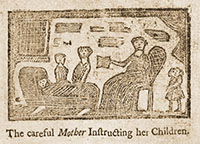from History of Lehigh County, Pennsylvania, Volume 2 by Lehigh County Historical Society, "Bloss Family," by Clinton J. Bloss.
The Bloss family whose descendants are especially numerous in Lehigh and in Carbon counties, trace their ancestry to the progenitor, Conrad Bloss, who emigrated from southern Germany. He sailed from Rotterdam on the ship Francis and Elizabeth, commanded by Capt. Geo. Worth, and landed at Philadelphia Sept. 21, 1742. Besides Conrad Bloss, we have record of the following coming to America and landing at Philadelphia.
Geo. Conrad Bloss, ship Lydia, John Randolph Capt. from Rotterdam, qualified Oct. 13, 1749
Jacob Bloss, ship Two Brothers, Thomas Arnt Capt., from Rotterdam, qualified Aug. 28, 1750.
Michael Blaass, ship Neptune, Geo. Smith, Capt., from Rotterdam, last from Gosport, qualified Oct. 7 1755.
Peter Blaass, ship Chance, Charles Smith, Capt., from Rotterdam, last from Cowes, qualified Sept. 23, 1766.
It is not known what relationship existed, if any, between Conrad Bloss and each of the four persons just mentioned; doubtless some kinship did exist. Nor do we know up to the present time of living descendants from any one of them except from Conrad Bloss.
Conrad Bloss, a weaver by trade, settled in Washington township, this county, then Heidelberg township, Northampton county. The exact time is not known, but as early as Oct. 4, 1749, he took out a warrant for twenty-five acres of land in Bucks county, which then embraced all of what is now Lehigh county.
On May 30, 1750, he took out a warrant for a tract of fifty-six acres and thirteen perches called Issenberg,
on May 9, 1765, he purchased from John Engel Thomas a tract called Manheim, which was taken out by a warrant dated Oct. 19, 1757, for 139 acres;
on April 9, 1767, he purchased from the heirs of Jacob Shellhammer a tract called Berlin of fifty-eight acres.
The last three tracts are embraced in a patent that was granted April 10, 1767, to Conrad Bloss, by Thomas Penn and Richard Penn.
On Aug. 25, 1765, he made application for twenty-five acres and in pursuance of warrant No. 623 dated Aug. 14, 1766, there was granted to him Aug. 25, 1766, a tract of twenty-five acres and fifty perches called Schwabenstadt.
Another warrant was taken out for twentyeight acres and thirty-two perches on Aug. 14, 1766. The total land he owned amounted to 331 acres and ninety-five perches.
In the Proprietary Tax list of 1772, Conrad Bloss, farmer, is assessed one pound and four shillings.
The first official act in recognition of Heidelberg as a township was made at the October term of court 1752, when Conrad Bloss was appointed constable for it.
Concerning the other four persons who came to America; namely, George Conrad, Jacob, Michael, and Peter Bloss, no more is known at the present time than what is noted in the following:
According to the Lutheran Church records of New Hanover (Falckner Swamp) Church in Montgomery county, George Conrad Bloss was married to Mary Catherine. On Oct. 7, 1750, their daughter Eva Elizabeth, born Sept. 7, 1750, was baptized; Frederick Bassler and wife were the sponsors. The records of St. Michael's German Evangelical Lutheran congregation of Philadelphia, state that on Feb. 24, 1754, Jacob Bender and wife Christina Sautere (Vulgo Langin) Jacob Bloss, acted as sponsors for Heinrich Jacob Moll, a son of Michael and Magdalena Moll; also, on May 15, 1758, Jacob Bloss married Rosina Sauerbreyin. The witnesses were Carl Ewald and Adam Fuchs. On Nov. 18, 1788, a Peter Bloss was united in marriage to Ann Richardson, as is recorded in the records of the First Presbyterian Church of Philadelphia. It is doubtful whether this is the Peter Blaass who came to Philadelphia in 1766.


